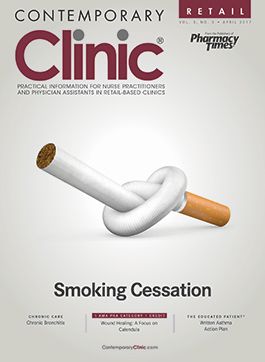COPD in the Retail Clinic
When retail health care providers see COPD patients, they should monitor comorbidities, refer patients when problems arise, and adjust medication when current treatment appears to be failing.
When retail health care providers see COPD patients, they should monitor comorbidities, refer patients when problems arise, and adjust medication when current treatment appears to be failing. Even if patients have comorbidities, clinicians must manage COPD in the same way and as simply as possible because simple regimens improve adherence.
Immunization is a critical preventive measure. The GOLD guideline recommends pneumococcal vaccine, which may reduce mortality. It also recommends influenza vaccine, which may reduce acute COPD exacerbations. With the recent increase in cases of pertussis across the country, vaccinating against this illness is also reasonable.
Choice of inhaler is important because many patients struggle with inhalers. GOLD 2017 emphasizes ensuring that patients use inhaler devices correctly and addressing poor adherence or correcting inhaler technique early. The guideline highlights initiating treatment with either a long-acting muscarinic antagonist or a long-acting beta2-agonist. If symptoms or exacerbations persist, it steps up to combination treatment. One change is new: GOLD 2017 acknowledges the growing indecision about high-dose inhaled corticosteroids as evidence accumulates to confirm the adverse effects of these corticosteroids.
stTM
Inhalers are drug-device combinations (DDCs), and clinicians need to ensure that patients can use them appropriately. Available DDCs require some degree of eyesight-and-hand coordination, but older individuals often have difficulty with vision, dexterity, and grip strength. Clinicians must consider each patient’s limitations and select the appropriate device. Manufacturers market 3 main types of inhalers: meter dose inhalers (MDI), dry powder inhalers (DPI), and a newer Soft Mitechnology. In addition, a new type of DPI called the Ellipta® inhaler was introduced in 2013 (FDA, 2015). Each has pros and cons.
Guideline-based treatment for COPD has proven benefits. It improves lung function, symptoms, exercise tolerance, and quality of life. It also reduces the number of exacerbations and hospitalizations.

Knock Out Aches and Pains From Cold
October 30th 2019The symptoms associated with colds, most commonly congestion, coughing, sneezing, and sore throats, are the body's response when a virus exerts its effects on the immune system. Cold symptoms peak at about 1 to 2 days and last 7 to 10 days but can last up to 3 weeks.
COPD: Should a Clinician Treat or Refer?
October 27th 2019The Global Initiative for Chronic Obstructive Lung Disease (GOLD) defines the condition as follows: “COPD is a common, preventable, and treatable disease that is characterized by persistent respiratory symptoms and airflow limitation that is due to airway and/or alveolar abnormalities usually caused by significant exposure to noxious particles or gases.â€
Diabetic Ketoacidosis Is Preventable With Proper Treatment
October 24th 2019Cancer, diabetes, and heart disease account for a large portion of the $3.3 trillion annual US health care expenditures. In fact, 90% of these expenditures are due to chronic conditions. About 23 million people in the United States have diabetes, 7 million have undiagnosed diabetes, and 83 million have prediabetes.
What Are the Latest Influenza Vaccine Recommendations?
October 21st 2019Clinicians should recommend routine yearly influenza vaccinations for everyone 6 months or older who has no contraindications for the 2019-2020 influenza season starting at the end of October, according to the Advisory Committee on Immunization Practices.
What Is the Best Way to Treat Pharyngitis?
October 18th 2019There are many different causes of throat discomfort, but patients commonly associate a sore throat with an infection and may think that they need antibiotics. This unfortunately leads to unnecessary antibiotic prescribing when clinicians do not apply evidence-based practice.
